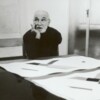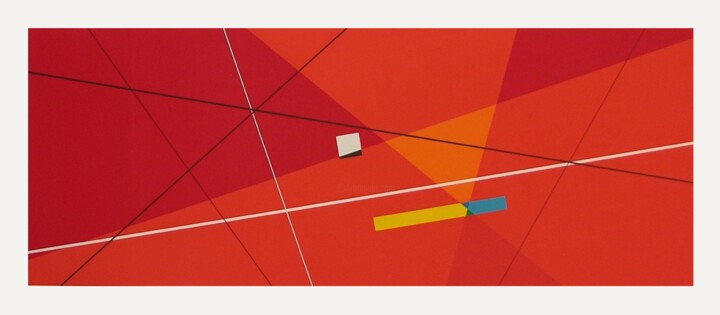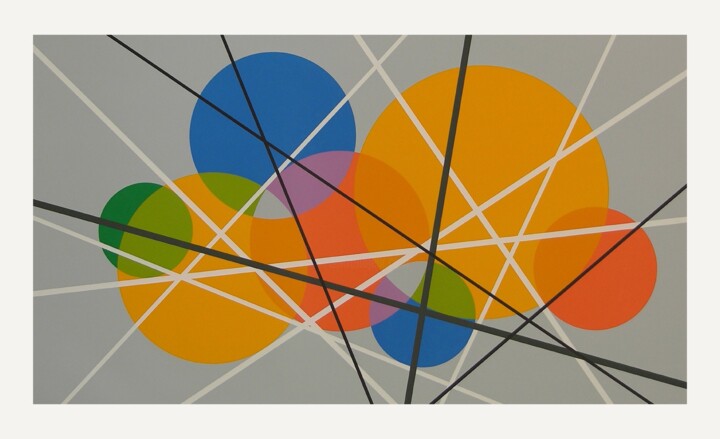Luigi Veronesi (Milan, May 28, 1908 – February 25, 1998) was a versatile Italian artist known for his work in painting, photography, filmmaking, and set design. His journey into photography began at 17, inspired by his father’s darkroom.
In the 1920s, Veronesi studied textile design and conducted photographic research, creating unique images. Introduced to intellectual circles by Raffaele Giolli, he turned to painting, studying under Carmelo Violante at the Accademia Carrara in Bergamo.
Key Exhibitions and Artistic Transition
- 1934: Participated in Italy's first collective art show in Turin with artists like Lucio Fontana.
- 1936: Showcased work at the Milan Triennale and the Como art exhibition.
- 1939: Held a solo exhibition at Galerie L'Equipe in Paris and published "14 variazioni su un tema pittorico."
Initially, Veronesi's works were figurative. However, by 1932, influenced by F. Léger and constructivism, he embraced geometric abstraction. He joined the Abstraction-Création group and adopted Bauhaus methodologies, influenced by Wassily Kandinsky. Active in theater and film, Veronesi created six experimental films, though only fragments remain.
During WWII, Veronesi utilized his graphic skills for the national liberation movement. After the war, he co-founded the photography collective La Bussola and worked extensively as a graphic designer. In 1949, he joined the Movimento per l'Arte Concreta (MAC) and participated in group exhibitions.
Veronesi explored the translation of musical notes into color, creating "Musica visiva," a concept expanded by Sergio Maltagliati in the 1990s. In the 1970s, he was appointed to the Chair of Chromatology and Composition at the Accademia di Belle Arti di Brera.
Later Career and Achievements
- 1979: Participated in Venice 79 La fotografia, organized by UNESCO and ICP of NY.
- 1983: Received the Feltrinelli Prize for painting.
- 1987: Collaborated on the Lavatoio Comunale project in Ulassai, Sardinia.
- 1980s: Designed stage sets for Teatro alla Scala in Milan, with sketches now in the theater's museum.
Luigi Veronesi passed away in Milan in 1998. His work is celebrated for its innovative blend of art and science and its significant impact on modern Italian art.
Style, Movement, and Subjects
Veronesi is best known for his involvement in the geometric movement, characterized by the use of geometric forms and a non-representational approach. His production often features clean lines, precise shapes, and a harmonious balance of colors, reflecting his deep interest in mathematical principles. Veronesi's style was influenced by Constructivism and Bauhaus, movements that emphasized the integration of art, design, and architecture.
An Artistic Evolution
Luigi Veronesi's early work at Galleria Il Milione in Milan began with a figurative style before shifting to abstract art, influenced by Constructivism and Communism. He used cyanotype photograms post-1932 to explore metaphysical properties. In 1934, he exhibited xylographs with Josef Albers, joined Abstraction-Création, and adopted Bauhaus techniques. He took part in Italy's first collective abstract art show in 1935 with notable artists like Lucio Fontana. By 1936, he illustrated Leonardo Sinisgalli's geometry book and exhibited at the Milan Triennale and in Como. Experimenting with photograms, he combined photographic images with oil on canvas, showcased in a solo exhibition in Paris from 1938 to 1939. Veronesi's work integrated musical notes with color relationships, later developed by Sergio Maltagliati. Post-WWII, he co-founded La Bussola, joined the Arte astratta arte concreta exhibition in 1947, and the Movimento Arte Concreta in 1949, also having a significant career in graphic design. His transition to abstract art and innovative techniques, including the integration of music and mathematics, solidify his legacy in modern art.
 COSTRUZIONE ARANCIO XXL (1989) Printmaking by Luigi Veronesi
COSTRUZIONE ARANCIO XXL (1989) Printmaking by Luigi Veronesi
Analysis of the work
"Costruzione Arancio XXL" (1989)
"Costruzione Arancio XXL" is a striking example of Luigi Veronesi's expertise in geometric abstraction. This print showcases his signature use of vibrant colors and precise geometric forms. The dominant red and orange hues create a dynamic background, intersected by thin, black lines that form intricate patterns. A small white square and a colorful rectangular bar add focal points that draw the viewer's eye across the composition. Veronesi's meticulous alignment of shapes and lines reflects his deep interest in mathematical precision and harmony. This piece embodies the synthesis of art and science, illustrating Veronesi's ability to convey complexity and order through abstract means.
 COSTRUZIONE BLU XXL (1989) Printmaking by Luigi Veronesi
COSTRUZIONE BLU XXL (1989) Printmaking by Luigi Veronesi
"Costruzione Blu XXL" (1989)
"Costruzione Blu XXL" is a large-format aquatint by Luigi Veronesi, showcasing his geometric style. The composition features bold, intersecting shapes and vibrant colors against a blue background, dominated by a deep blue circle overlapping a smaller white circle. Interlocking red, yellow, and green forms, outlined in black, create dynamic harmony. Reflecting Constructivist and Bauhaus influences, the piece emphasizes the integration of art and science through precise geometric forms and color theory. The aquatint technique enhances the depth and vibrancy, exemplifying Veronesi's balance of aesthetic beauty and structural precision.
 COSTRUZIONE GRIGIA XXL (1992) Printmaking by Luigi Veronesi
COSTRUZIONE GRIGIA XXL (1992) Printmaking by Luigi Veronesi
"Costruzione Grigia XXL" (1992)
"Costruzione Grigia XXL" is a large-format screenprint showcasing Veronesi's expertise in geometric art. The piece features overlapping circles in vibrant colors against a grey background, intersected by dynamic black and white lines, creating depth and movement. The contrast between bold primary colors and softer hues enhances the visual impact. Reflecting Constructivist and Bauhaus principles, the piece demonstrates Veronesi's integration of art and science through precise geometric forms and mathematical structure. This screenprint exemplifies his innovative approach, utilizing sharp lines and vibrant colors to create a striking composition.
Teaching Career, Later Career, and Legacy
From 1963 to 1979, Luigi Veronesi taught graphic arts in the graduate industrial design course in Venice and later became a professor of color science at the Brera Academy in Milan, influencing many artists with his expertise in chromatics and design.
In the 1980s, he participated in the 33rd Venice Biennale, held solo exhibitions in Bolzano (1980) and Pordenone (1984), and co-authored a book on Genesio De Gottardo in 1989. Veronesi synthesized various European avant-garde movements and left a rich artistic legacy upon his death in Milan in 1998.
Veronesi inspired a generation of artists who explore the intersection of art and science, particularly in geometric art and multimedia approaches.
Famous Artworks, Shows, and Art Market Presence
Veronesi is known for his "Composizione" series of geometric paintings and the innovative "Fotogrammi" series in experimental photography, highlighting his attention to form, color, light, and shadow.
His work has been featured in prestigious shows worldwide, including the Venice Biennale, and commands high prices at auctions, sought after by collectors and institutions.
Theater and Cinema Contributions
Veronesi produced nine experimental films (seven destroyed in WWII) and was involved in national scenography displays and opera set design. He collaborated with Giorgio Strehler on Luigi Pirandello productions and designed numerous sets for the Scala Theater in Milan into the late 1980s.


 Selena Mattei
Selena Mattei



